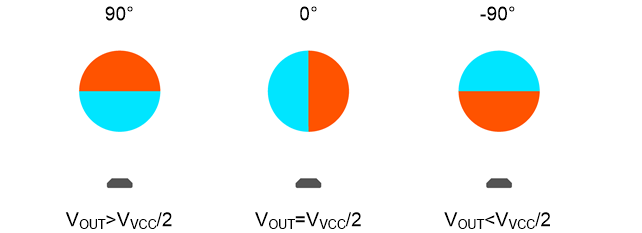SLYA036B July 2018 – November 2021 DRV5053 , DRV5053-Q1 , DRV5055 , DRV5055-Q1 , DRV5056 , DRV5056-Q1 , DRV5057 , DRV5057-Q1
- Trademarks
- 1Introduction
- 2Overview
- 3Device Descriptions
-
4Methods
- 4.1 Uncalibrated Implementations
- 4.2 Peak Calibrated Implementations
- 4.3 Lookup Table Calibration Implementations
- 4.4 Peak Calibrated Plus Lookup Table Hybrid
- 5References
- 6Revision History
4.1.1.1 General Implementation
The peak amplitude of the signal is unknown with an uncalibrated system. Therefore, the only usable information from the sensor is whether VOUT is greater or less than VVCC / 2, as shown in Figure 4-1. This information indicates whether the magnet is pointing towards a degree range (or region) where the sensor is sensing more north or more south polarity. The number of regions for a system depends on the number of sensors used.
 Figure 4-1 Uncalibrated Sensor Positions
Figure 4-1 Uncalibrated Sensor Positions